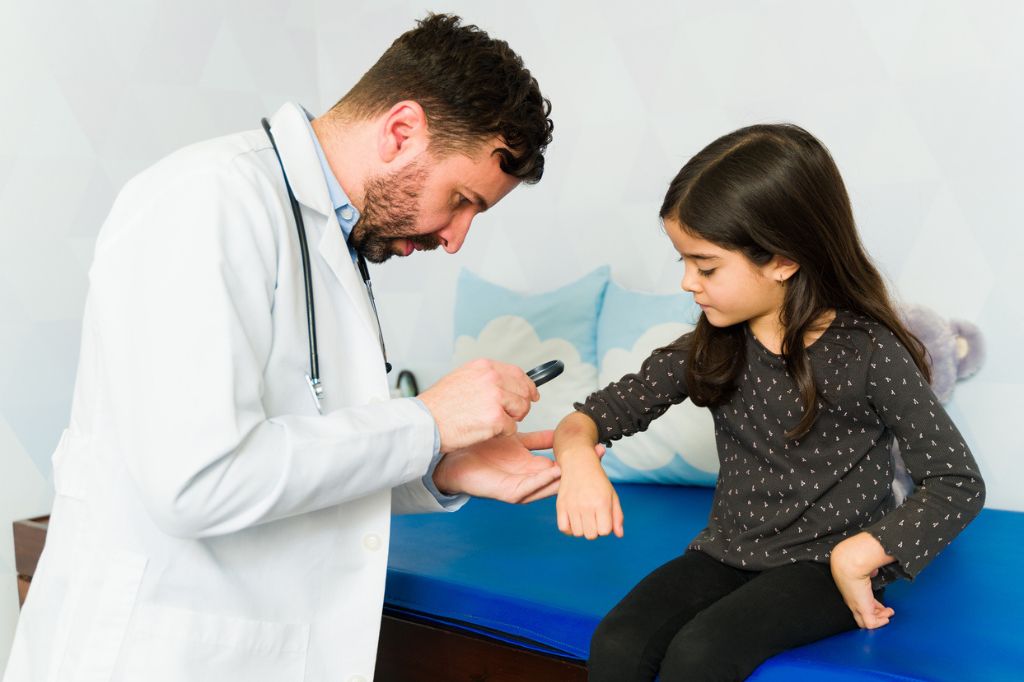Pediatric dermatology involves diagnosing and treating skin conditions in infants, children, and adolescents. Children’s skin, while resilient, can be prone to a variety of issues unique from those of adult patients. A pediatric dermatologist first completes medical school, then general training in pediatrics or medicine, then dermatology residency, and finally a pediatric dermatology fellowship.

Common Pediatric Dermatology Conditions
Eczema (Atopic Dermatitis)
Eczema is one of the most common skin conditions, which is characterized by dry, itchy, and inflamed areas. It may present in infancy on most of the body (often sparing the diaper area), while patients over 2 years of age are more commonly affected by eczema in the creases of the body (flexural), scattered coin-shaped lesions (nummular), and/or chronic hand and foot involvement.
Treatment: Gentle skin care with avoidance of fragrance, added plant botanicals and harsh irritants is essential. Moisturizing creams or ointments are fundamental in managing eczema, along with topical steroids and non-steroidal treatments to reduce inflammation and discomfort. Systemic medications to treat inflammation are sometimes indicated when active eczema and itch are not well-controlled with topical medications.
Diaper Rash
Diaper rash is a widespread issue among infants and toddlers, resulting from the irritation of sensitive skin by wet-to-dry changes, frequent stooling, friction, infrequently changed diapers, irritating fragrances and preservative agents in wipes, and other factors.
Treatment: Frequent diaper changes, absorbent diapers, zinc oxide creams or barrier emollient ointments can help prevent diaper rash. For more severe cases, a pediatric dermatologist may prescribe medications.
Warts
Warts are a very common viral infection of the skin in both young children and teenagers, and are caused by the human papillomavirus (HPV). They are spread by skin-to-skin contact or contact with an inoculated surface.
Treatment: Treatments may include topical creams or gels used frequently at home, taping to keep the warts from spreading, cryotherapy (freezing), cantharone (“beetle juice”) solution applied in-office, and candida (“yeast”) antigen injections. Patience is key, as warts can be stubborn and may persist for years – even with some treatments.
Molluscum Contagiosum
This is the most common viral infection of the skin in children. It causes small, skin-colored or pearly, dome-shaped bumps on the skin and is highly contagious among younger children. It usually spreads by skin-to-skin contact, via small aquatic environments (e.g. bathtubs), or wet towels.
Treatment: Molluscum contagiosum eventually resolves on its own. However, when the bumps are attacked by the immune system, they often become red, irritated, and crusted. You and your provider may consider treatments to speed up the process, including topical therapies and physical destruction methods.
Acne
Acne is very common in teenagers and can vary widely in severity. It may appear as pimples, blackheads, whiteheads, and cysts, primarily on the face, chest, and back.
Treatment: A gentle skincare routine is recommended, along with topical or oral medications for more severe cases. A pediatric dermatologist can provide guidance tailored to the child’s age and the severity of their acne.
Port Wine Birthmarks/ Capillary Malformations
Port wine birthmarks are common congenital vascular malformations that appear as a red or purple mark on the skin, often noted at birth. They are caused by a genetic change in a gene called GNAQ in the area(s) affected. They may occur anywhere on the body.
Treatment: Laser therapy, specifically with the pulsed dye laser, is the most effective treatment for reducing the appearance of port wine birthmarks. This may be started as early as 4 weeks of age, and may be continued at regular intervals throughout life. Birthmarks on the face and neck respond much better than those on the lower body, especially the legs. Serial treatments are usually required for optimal results, and early intervention is recommended for the best outcomes to prevent subsequent thickening and darkening of the birthmark over time.
Treatments and Care at Cascade Eye & Skin Centers
At Cascade Eye & Skin Centers, we understand the importance of specialized care for our youngest patients. Our pediatric dermatology services are designed with children’s unique needs in mind, from the comfort of our facilities to the gentleness of our treatments.
We believe in a holistic approach, considering not just the physical symptoms but also the emotional and psychological well-being of our pediatric patients.
In addition to clinical expertise, we offer state-of-the-art technologies to address our patients’ concerns, including advanced laser procedures for the treatment of vascular birthmarks (e.g. port-wine birthmarks), traumatic scars, and acne scars – to name a few.
Click here to learn about our pediatric dermatologist, Ross Brockman, DO.
When to See a Pediatric Dermatologist
Whether your child is a newborn with a developing skin concern or a teenager who is experiencing persistent skin problems, it’s essential to consult with a pediatric dermatologist. Early intervention can prevent complications, reduce discomfort, and provide caregivers with peace of mind.
If your child is facing a skin condition, remember, you’re not alone. The team at Cascade Eye & Skin Centers is here to support you with expert care and comprehensive treatment options. Click here to schedule a pediatric dermatology appointment and learn how we can help your child achieve healthy skin they can be happy in.




